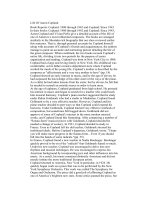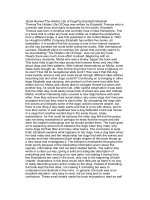claude oscar monet life of 434
Bạn đang xem bản rút gọn của tài liệu. Xem và tải ngay bản đầy đủ của tài liệu tại đây (33.74 KB, 1 trang )
Claude Oscar Monet was born November 14, 1840 in Paris, France. The initiator, advocate, and
leader of the Impressionist style, Claude Monet's many works of art serve as the definition of the
Impressionist's artwork.
His father, Adolphe Monet, a grocer in Paris, brought the family to Le Havre when Claude was
five. Struck by the constantly changing sea and sky on the coast, Claude would go on to put these
onto a canvas. Before this however, he started to paint caricatures for locals.
Probably to the disappointment of his parents, Claude decided not to go to l'Eglise de Beaux-Arts
in Paris. Instead, he studied art under local artists and developed much promise. One of these was
Eugene Louis Boudin, who painted coastal landscapes.
Despite this, he would move to Paris in 1859 to attend l'Academie Suisse, where he met Camille
Pissaro. He was sent to Algeria for military service from 1860-62. After his return he enrolled in
the studio of Charles Hleyre, where he would meet Pierre Auguste Renoir, Frederic Bazille, and
Alfred Sisely. It was at the studio that Claude would participate in a rare practice.
Many European artists of the day painted landscapes, but they were most often painted in the
studio, with a basic feeling of what the scene looked like. Monet painted outdoors. By 1865 he
was painting marine and forest subjects, townscapes, and figures in landscape settings, all
outdoors.
In the summer of 1869, he worked with Renoir to lead the creation of outdoor impressionism. In
what is now known as a signature of impressionism, he favored rivers with light dappled water and
scenes in which brushstrokes dissolve the forms of objects by breaking brushstrokes and patches
of color into their contours.
Then in 1876 he enacted his plan to paint a single object from several viewpoints. He picked as
his subject Gare Saint-Lazare, a train station in Paris.
Despite his talent, Monet had to endure extreme poverty. This was like this until the 1880s when
Monet's works began to sell for a higher price. He was then free to paint as he pleased. He once
again started doing studies of objects. Some of his subjects included haystacks, poplar trees, the
facade of Rouen Cathedral, the Seine at Giverny, and view of the River Thames and the Houses of
Parliament. But after 1890 his main subject was the lily pond in his backyard.
Monet died December 5, 1926. Behind him he left his works and a new style of art -
impressionism.
SOURCE:
Roskill, Mark. "Monet, Claude." 2002 Grolier Multimedia Encyclopedia. New York City: Grolier
Interactive, Inc., 2001. CD-ROM.









